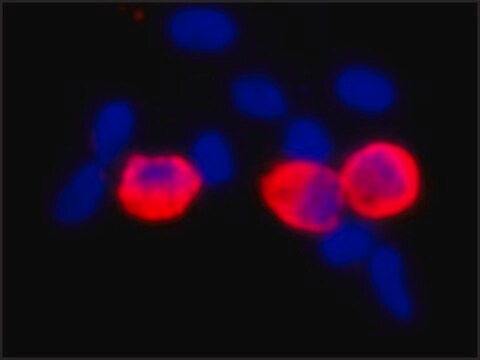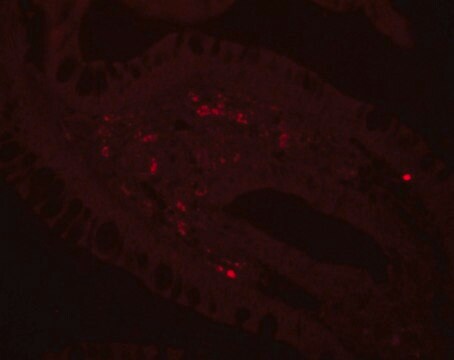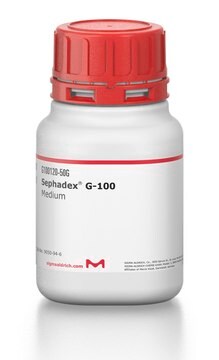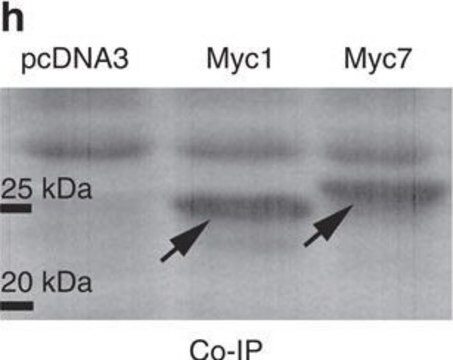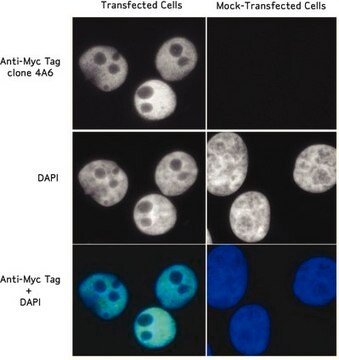A5598
Anti-c-Myc−Peroxidase antibody produced in rabbit
affinity isolated antibody, buffered aqueous solution
Synonym(s):
Anti-c-Myc antibody produced in rabbit
Sign Into View Organizational & Contract Pricing
All Photos(1)
About This Item
Recommended Products
biological source
rabbit
Quality Level
conjugate
peroxidase conjugate
antibody form
affinity isolated antibody
antibody product type
primary antibodies
clone
polyclonal
form
buffered aqueous solution
species reactivity
human
concentration
1.8-4 mg/mL
technique(s)
western blot: 1:5,000
UniProt accession no.
storage temp.
−20°C
Gene Information
human ... MYC(4609)
Looking for similar products? Visit Product Comparison Guide
General description
The Anti-c-Myc peroxidase conjugate rabbit antibody reacts with c-Myc tagged fusion proteins. It recognizes the c-Myc tag sequence expressed at either the amino- or the carboxyl-terminus.
Specificity
N-terminal or C-terminal c-Myc (Glu-Gln-Lys-Leu-Ile-Ser-Glu-Glu-Asp-Leu) tagged fusion proteins.
Immunogen
peptide corresponding amino acids 408-425 of the human c-myc proto-oncogene, conjugated to maleimide-activated KLH through a C-terminal added cysteine residue.
Application
Antibody is suitable for immunoblotting.
Applications in which this antibody has been used successfully, and the associated peer-reviewed papers, are given below.
Western Blotting (1 paper)
Western Blotting (1 paper)
Physical form
Solution in 0.01 M sodium phosphate buffer saline, pH 7.4, containing 0.05% MIT
Preparation Note
Prepared by the two-step glutaraldehyde method described by Avrameas, S., et al., Scand. J. Immunol., 8, Suppl. 7, 7 (1978).
Not finding the right product?
Try our Product Selector Tool.
Signal Word
Warning
Hazard Statements
Precautionary Statements
Hazard Classifications
Skin Sens. 1
Storage Class Code
12 - Non Combustible Liquids
WGK
WGK 2
Flash Point(F)
Not applicable
Flash Point(C)
Not applicable
Choose from one of the most recent versions:
Already Own This Product?
Find documentation for the products that you have recently purchased in the Document Library.
Customers Also Viewed
Yang Lu et al.
Molecular biology of the cell, 19(10), 4260-4272 (2008-08-08)
Efg1 is essential for hyphal development and virulence in the human pathogenic fungus Candida albicans. How Efg1 regulates gene expression is unknown. Here, we show that Efg1 interacts with components of the nucleosome acetyltransferase of H4 (NuA4) histone acetyltransferase (HAT)
Rodolfo Zentella et al.
Nature chemical biology, 13(5), 479-485 (2017-03-01)
Plant development requires coordination among complex signaling networks to enhance the plant's adaptation to changing environments. DELLAs, transcription regulators originally identified as repressors of phytohormone gibberellin signaling, play a central role in integrating multiple signaling activities via direct protein interactions
Gang Li et al.
Nature cell biology, 13(5), 616-622 (2011-04-19)
The circadian clock controls many metabolic, developmental and physiological processes in a time-of-day-specific manner in both plants and animals. The photoreceptors involved in the perception of light and entrainment of the circadian clock have been well characterized in plants. However
Zirui Zheng et al.
Journal of immunology (Baltimore, Md. : 1950), 196(3), 1199-1208 (2015-12-25)
IFN regulatory factors play a pivotal role in many cellular processes, including inflammatory and immune responses. Their activation is tightly regulated by TANK-binding kinase 1 (TBK1). In response to microbial components, TBK1 activates IFN regulatory factor 3 (IRF3) and cytokine
Du-Hwa Lee et al.
The Plant cell, 29(11), 2895-2920 (2017-11-01)
Dynamic control of protein translation in response to the environment is essential for the survival of plant cells. Target of rapamycin (TOR) coordinates protein synthesis with cellular energy/nutrient availability through transcriptional modulation and phosphorylation of the translation machinery. However, mechanisms
Our team of scientists has experience in all areas of research including Life Science, Material Science, Chemical Synthesis, Chromatography, Analytical and many others.
Contact Technical Service